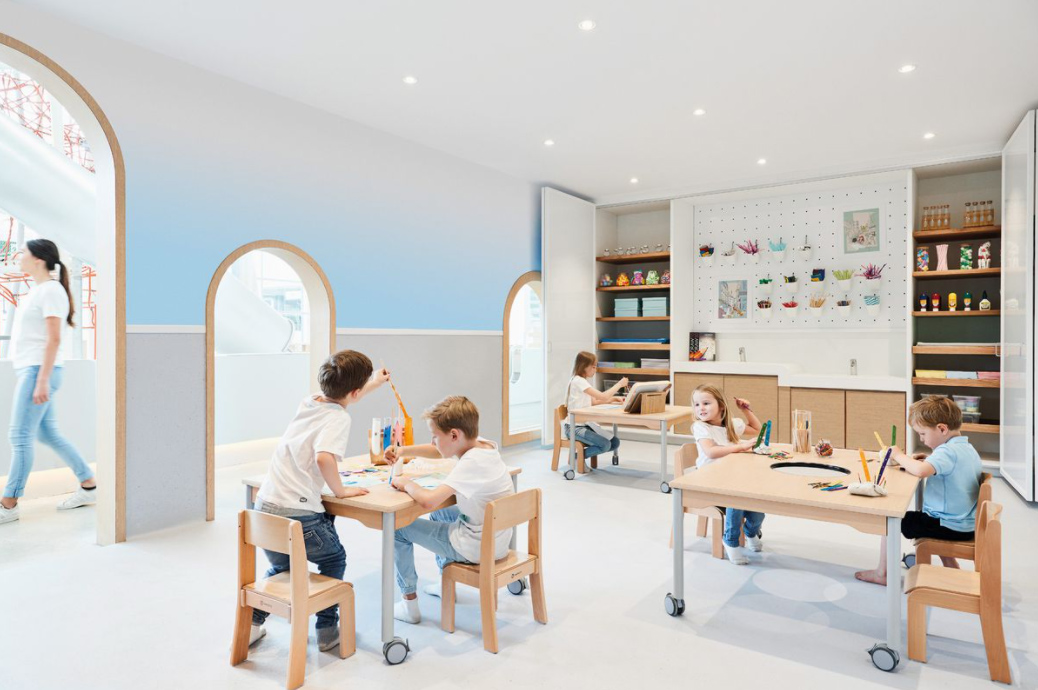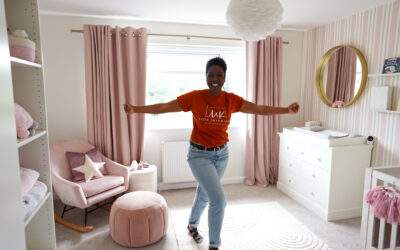The Baby room: 3 months – 2 years old

Within a baby room, a milk kitchen area is needed to make and prepare bottles, a nappy changing area and a sleeping space for cots for children to sleep. The room also needs to be bright and spacious.
Perhaps you could consider a black and white area in the baby room for visual stimulation for babies because in the first few months of a babies life there are limitations in their vision and they respond well to simple bold patterns with high contrast. These types of toys and resources will support their visual development, inviting babies to engage whilst offering stimulation that will keep them captivated for short periods of time. The visual contrast encourages babies to explore the different patterns and textures offered, giving a multi-sensory experience to young explorers. Strong black and white patterns also help babies to develop their ability to focus.
Things need to be accessible to babies and at their level. Resources for a baby room will consist of:

-Rattles
-Textured materials consisting of ruff, smooth, rigid, soft, hard etc
-Wooden toys eg building blocks, shape sorters,
-Metal objects- pots, pans, spoons,
-Mirrors
-Access to water play
-Access to sensory play ie shaving foam, tissue paper, cornflour and water etc
-Art resources paints, paintbrushes, sponges, paper, crayons
-Interactive toys with buttons, flaps, knobs etc
-Books including textured and interactive ones
-High chairs
-Tables and chairs for children who no longer require highchairs
Toddler nursery room: 2-3 years

As the children get to toddlers, designing spaces that encourages, reading and writing, such as a cosy corner surrounded by books at their level, furniture that encourages active movement, tables for table top activities. Wall spaces should be accessible to children with tactile elements and drawing boards where possible. A place to sleep and rest are extremely important.
At 2-3 years old , this is the stage in a child’s development when stimulation is required to enable them to discover the world around them. During this stage children are encouraged to become more independent with things and begin to think for themselves.
Within this type of room, you would expect the indoor environment to consist of resources that are age appropriate, well maintained, and accessible for all children within the room.
The activities and resources which would be used in this age group would reflect upon the following themes:
Role Play Area– To develop language skills, social and listening skills by the use of dolls, teddies and simple everyday objects. (If space is limited perhaps you could consider changing your role play area every two months to something related to the current topic/theme you are focusing on that month)
Messy Play – To encourage fine motor skills and creative exploration of objects using all the five senses.
Sensory Play – To encourage all aspects of sensory development, exploring objects, developing attention and concentration, hand-eye co-ordination and making simple preferences, choices and begin to assign words and attributes to objects.
Family Books/ Scrap Books – To encourage a child’s own self-esteem, positive self-image and links between home and nursery. (This can be done on a display board on a wall, and/or in a scrap book made to be placed in the book corner)
Book Area – To encourage an early love of books and developing language by sharing them with a caring adult and with peers.
Sand and Water Play – To encourage exploration of objects using a child-focused approach.

Toys and resources needed are:
-Musical instruments
-Trains, cars
-Natural materials e.g. wood items
-Building blocks and connecting tools
-Threading toys
-Jigsaw puzzles
-Small world toys- animals, dressing up clothing, boats, spades/ buckets, torches, toys phones etc.
-Paints, crayons, art supplies that are age appropriate

The layout of the room will incorporate the different areas mentioned above and when designed and setup they should be identifiable for the children.
There also needs to be space for eating (consisting of table and chairs which are age appropriate and can accommodate the maximum number of children in the nursery on one given day) There needs to be a preparation area for serving meals, shelving unit to place cutlery, cups, plates, bowls, water station (where children can pour their own water into cups) and accessible to children to encourage independence and self-service.
Nappy changing area with a designated sink to wash hands for those children that are in nappies. Child level toilets are essential for their toilet training transition.
Pre-school Nursery Room: 3-5 years
The 3-5 years room will consist of the same things which is provided within a 2-3 year old room however the room will be a bit more challenging for the children in terms of getting them ready for when they start school as this is the stage where the children are encouraged to be more independent.
There also needs to be space or a eating area (consisting of table and chairs which are age appropriate and can accommodate the max number of children in on one given day) eg preparation area for serving meals, shelving unit to place cutlery, cups, plates, bowls, water station (where they can pour own water into cups)and accessible to children so that they can become independent and carry out self-service.

Toilets with hand basins so that the children are able to go to toilet as and when they need to independently (If there is space within the room, if not the toilets can be outside the room however, the children will need to be supervised and not left alone).
The Sensory Room
A sensory room is an interactive space filled with light, colour, texture and sound. The sensory room in a day nursery benefits everyone of all ages and abilities. They are seen as a therapeutic space that helps to foster hand-to-eye co-ordination, social skills, colour recognition and language development. It also offers a calm, comforting safe place for relaxation, essential for your child’s emotional health.
Abigail Cambridge
Senior Early Years Practitioner




0 Comments
Trackbacks/Pingbacks